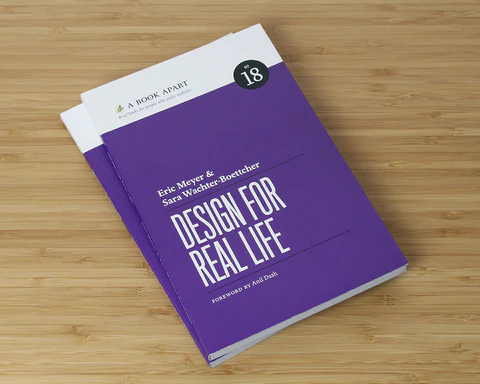Happy Bookiversary to Design for Real Life!
Apr 03, 2019


This week, we’re celebrating three years since the launch of Design for Real Life by Eric Meyer & Sara Wachter-Boettcher! First up is a Q&A with Sara, a product and content strategy consultant, speaker, and author of Technically Wrong: Sexist Apps, Biased Algorithms, and Other Threats of Toxic Tech. She also cohosts Strong Feelings—a weekly podcast about work, friendship, and feminism—with ABA’s very own CEO, Katel LeDû. Read on for how she pushes past self-doubt, what she thinks tech needs less of, and a piece of advice that’s stuck with her since 2012.
ABA: What tool, object, or ritual could you not live without to get you through a week?
Sara Wachter-Boettcher: Exercise! I had knee surgery to repair a torn ACL last fall, and I spent a month in a locked leg brace from thigh to ankle. I even had to wear it to bed the first two weeks. It was really difficult for me to be unable to do any physical activity, and I realized how much I relied on it to keep me balanced mentally and emotionally. I’m glad my lack of mobility was only temporary, but it did make me think a lot about building other kinds of practices into my schedule that can keep me balanced if exercise isn’t an option.
ABA: In moments of self-doubt, how do you recharge and rally to keep going?
SWB: I turn to a close-knit crew of peers who I know I can say anything to and I’ll have their support. Since I work independently, for me that’s a couple small Slack groups made up of mostly women in tech and design, and I don’t know what I’d do without them. If you don’t have that kind of group you can turn to, I strongly recommend seeking out those connections!
ABA: Is there a piece of professional or life advice you’ve gotten that has always stuck with you? What is it?
SWB: Back in 2012, when I was working on my first book, I was scared and anxious. I was certain I had no idea what I was doing and was going to fall flat on my face. My friend Margot Bloomstein got on Skype with me, and shared some advice she had received when writing a book: you don’t have to be an expert at the start. You become the expert through writing (and the research and thinking that goes into the writing). Sure, some people write books based off of having decades of knowledge on a subject. But many, many excellent books are written by people who know enough to have developed a strong opinion or idea, and then find they want to push their knowledge further and share what they’ve learned. That’s a totally valid thing to do! I think the same advice applies to speaking or writing articles. People talk themselves out of it so quickly because they worry they don’t know enough—and then “enough” conveniently never comes. So I think about that advice a lot, and try to share it as often as possible.
ABA: Is there anyone you’re following the work of right now, who you’d recommend others pay attention to?
SWB: I just met a designer whose work I am really interested in, Eva PenzeyMoog. She’s working on the ways that tech products are used to enable domestic violence—from smart devices used to monitor a partner to banking sites and apps that enable financial abuse. She notes that in the United States, 89% of domestic violence cases involved tech-enabled abuse last year—but we rarely talk about it. I’m excited to see where her research takes her, and how we can get more people designing with safety and abuse in mind.
ABA: What does the tech industry need more of? Less of?
SWB: I think we need more emphasis on creating small, functional systems, and less emphasis on scale. Almost every conversation about building more ethical and inclusive tech seems to turn to, “but how will it scale?” immediately. We get lost in conversations about, say, the challenges of moderating abusive content at a massive company. But I’ve realized that focusing only on how ethical solutions can scale will not actually solve problems at scale. Because it’s the obsession with scale that actually got us here in the first place—to a place where our digital tools are used to surveil, harass, mislead, and otherwise harm us. Because focusing on scale actually means accepting that the current status quo has to stay intact—and if you can’t question the current status quo, if you can’t rethink the model, then you’re just going to make shallow “feel-good” improvements to a product, not correct deep underlying harms.

Next up, we interviewed Sara’s Design for Real Life coauthor, Eric Meyer. Since he started working on the web in 1993, he’s been a college webmaster, one of the original CSS Samurai members, a standards evangelist at Netscape, the author of many books and online resources, an occasional code artist, the technical lead at Rebecca’s Gift, and a cofounder of An Event Apart. Dang! Find out whose work he thinks we should all be following now, his go-to source for inspiration, and what he thinks someone should consider before starting out in working on the web.
ABA: What is your favorite thing about your workspace?
Eric Meyer: The afternoon sunlight. My home office is painted in light colors and has a hardwood floor, so it’s just very bright and warm as the sun meanders across my keyboard and into the room. Having a west-facing window is an advantage in the summer as well, since breezes generally come out of the west in my part of North America.
ABA: What’s the first thing you do every morning to start your day on the right foot?
EM: I try to have breakfast. It’s kind of a luxury to have the time to do that, but it always seems to help. And most weekdays for most of the year, I walk my son to school.
ABA: In your opinion, what should someone consider before starting out in web design / development?
EM: What is your purpose? What drives you to pursue this field instead of some other? What do you hope to accomplish with the web? Figure that out, and you’ll have a big leg up on where to focus and what opportunities to seek.
ABA: Is there anyone you’re following the work of right now, who you’d recommend others pay attention to?
EM: Zeynep Tufekçi, Sara Wachter-Boettcher, Troy Hunt, Sarah Jaime Lewis, Nadieh Bremer, and Nicky Case. I’m sure there are others that I’ll kick myself later for not mentioning, but those were the names that immediately came to mind.
ABA: What does the tech industry need more of? Less of?
EM: More care and consideration for who we’ll affect with our work, and how. More humility. Less gatekeeping. Way less venture capital.
ABA: In moments of self-doubt, how do you recharge and rally to keep going?
EM: I remind myself that the only people who never feel imposter syndrome are the ones who really should.
ABA: What is your go-to source of inspiration when you’re trying to get out of a creative rut?
EM: Time away from the rut. I’m lucky to have enough variation in the things I do that if I’m tired of coding, I can write; if I’m tired of writing, I can research; if I’m tired of researching, I can strategize; if I’m tired of strategizing, I can code. And so on.
ABA: Is there a fear or professional challenge that keeps you up at night? What is it?
EM: I usually don’t have fears keep me up at night, but when I do, they have nothing to do with work.
ABA: What characteristic do you most admire in other driven/creative people?
EM: The same characteristic I admire in anyone: kindness. Vonnegut was right.
ABA: What tool, object, or ritual could you not live without to get you through a week?
EM: The web. That probably sounds like a cop-out answer—why not credit “oxygen” next?—but I think we really undervalue it. The same way we do oxygen, I suppose.
ABA: What’s the biggest sacrifice you’ve made to do the work you do?
EM: Travel, which is really a small sacrifice compared to so many, but it’s hard being away from my family even for a few weeks out of each year.
ABA: Is there a piece of professional or life advice you’ve gotten that has always stuck with you? What is it?
EM: “It’s worth a little temporary discomfort to get to do something remarkable.” My grandfather told me that.
Buy your copy of Design for Real Life in paperback or ebook today! Order it along with any other ABA book to save 10% off both instantly—no code required.
